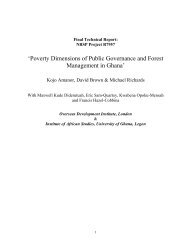Zimbabwe - Overseas Development Institute
Zimbabwe - Overseas Development Institute
Zimbabwe - Overseas Development Institute
You also want an ePaper? Increase the reach of your titles
YUMPU automatically turns print PDFs into web optimized ePapers that Google loves.
i n v o l v e an i n c r e a s i n g net l o s s of f o r e i g n exchange to the<br />
economy; or, again, i f the costs of inputs needed to produce the<br />
goods exceed the s e l l i n g p r i c e then production w i l l be taking<br />
place with negative value added. But these extremes do not have<br />
to be reached f o r a judgement to be made about the strength of a<br />
country's manufacturing sector. While employment c r e a t i o n i s<br />
c l e a r l y an important f a c t o r i n judging the c o n t r i b u t i o n of<br />
manufacturing to the whole economy, i t s o v e r a l l e f f e c t and<br />
impact on the wider economy i s c l e a r l y of fundamental s i g <br />
n i f i c a n c e . In t h i s regard i t i s important to analyse the<br />
competitiveness of the sector and i t s impact on earning and<br />
spending the country's scarce f o r e i g n exchange. Examining these<br />
f a c t o r s not only provides a deeper understanding of the dynamics<br />
of the sector, with i t s underlying strengths and weaknesses, but<br />
also equips one to assess b e t t e r i t s future prospects. I t i s i n<br />
t h i s context that we s h a l l now move on to examine a number of<br />
long term trends i n c l u d i n g the sources of growth, the i n t e r <br />
n a t i o n a l competitiveness of the sector and i t s o v e r a l l f o r e i g n<br />
exchange p o s i t i o n .<br />
2.3 Sources of I n d u s t r i a l Growth<br />
Following Lewis and S o l i g o (1965), Lewis' (1971) and Chenery<br />
(1960 and 1986), the "sources" of growth of <strong>Zimbabwe</strong>'s manuf<br />
a c t u r i n g sector i n the 30 year period 1952 to 1983 have been<br />
c a l c u l a t e d and decomposed i n t o t h e i r three c o n s t i t u e n t elementsimport<br />
s u b s t i t u t i o n , domestic demand and export growth.'= The<br />
r e s u l t s f o r the manufacturing sector as a whole are shown<br />
p i c t o r i a l l y i n Figures 4 and 5 and Table 2''. They reveal some<br />
i n t e r e s t i n g r e s u l t s .<br />
Of the t o t a l growth i n gross output of the manufacturing<br />
sector i n the period 1952 to 1983, most (over 25%) was a t t r i <br />
butable to the Foodstuffs sub-sector (1), with the f i r s t four<br />
sub-sectors ( f o o d s t u f f s , beverages and tobacco, t e x t i l e s and<br />
c l o t h i n g ) , the more consumer-oriented sub-sectors, accounting f o r<br />
an almost consistent 48-49% of t o t a l output growth. What<br />
d i s t i n g u i s h e s <strong>Zimbabwe</strong>'s record of manufacturing growth from so<br />
many other SSA c o u n t r i e s , however, i s the c o n s i s t e n t l y high<br />
proportion of t o t a l growth o r i g i n a t i n g i n the intermediate and<br />
c a p i t a l goods sub-sectors. Sub-sector 9, metals and metal<br />
products, was not only the one c o n t r i b u t i n g most to o v e r a l l<br />
growth, a f t e r f o o d s t u f f s , but i n the UDI period (1965-79) i t s<br />
rate of growth exceeded that achieved by the f o o d s t u f f s subsector.<br />
A d d i t i o n a l l y , the importance of sub-sector 7, chemicals<br />
and pharmaceuticals should be noted. In a l l , sub-sectors 3,7 and<br />
9 c o n s i s t e n t l y c o n t r i b u t e d between 57% and 60% to t o t a l manuf<br />
a c t u r i n g output growth throughout the 30 year period.
















